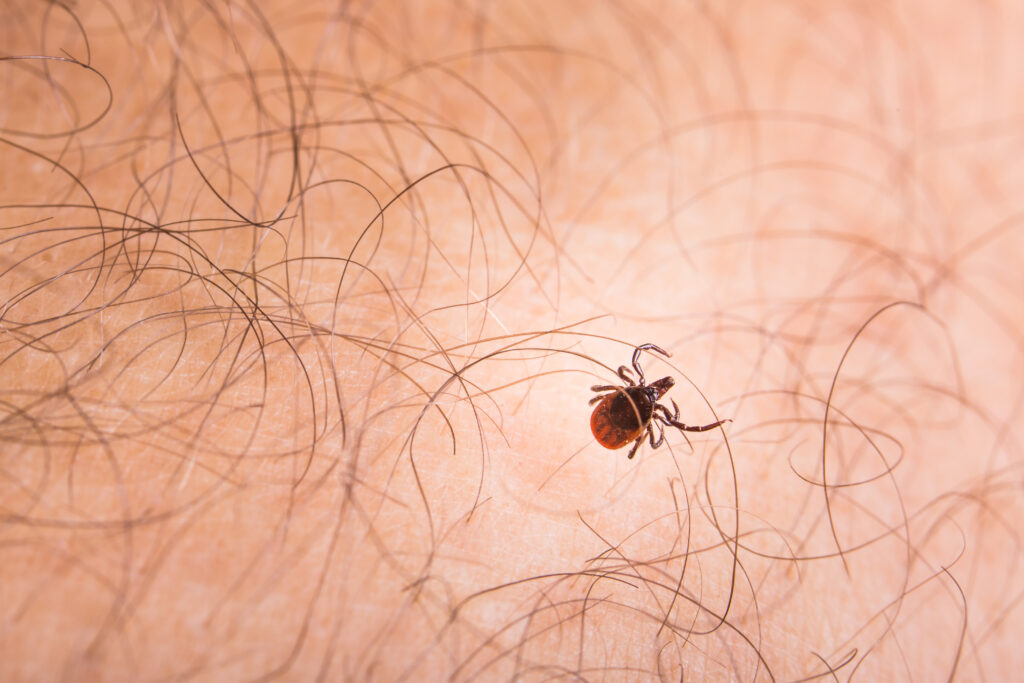Lyme disease can destroy your health and often does. Besides human health, pets can also pick up Lyme disease. One common sign is the bull’s eye rash on humans or the Lyme disease bright red circle on a dog’s belly. It worsens when symptoms go undiscovered, and untreated Lyme disease develops into chronic Lyme disease.
We want to inform our customers of the dangers of this tick-borne disease. More importantly, we want you to know that Safer Nature provides safe, traditional or organic pest control methods to manage tick populations.
What Is Lyme Disease?
Anyone diagnosed with a Lyme disease tick bite knows that the Borrelia burgdorferi bacteria causes the nasty symptoms of this disease. When a deer tick (also known as the black-legged tick) is infected, it spreads this infection when latching on to people, deer, and other animals.
High-risk months
Some statistics from the Massachusetts Department of Health (DOH) show that these ticks are most active from March and April to August and again from October to November. These timeframes depend on the weather.
Lyme disease statistics
Although the rates of Lyme disease infections differ between the Massachusetts counties, deer ticks, and their diseases occur throughout the state. Essex had 115 reported cases of Lyme disease and other tick-borne diseases in 2022, so 3.1 in every 10,000 people were affected. Dukes and Nantucket had the highest cases at 24,550, 91.65 incidents for every 10,000 people.
The trend of medical visits shows that children between 5 and 14 and older adults are the most at risk. Doctors often diagnosed these children with Lyme disease. In contrast, they diagnosed mature adults with Lyme disease, babesiosis, and anaplasmosis.
This information shows that there is a clear need to protect yourself. That protection starts with pest control in and around your home. But first, you need to recognize the symptoms of Lyme disease.
What Are the Lyme Disease Symptoms?
Lyme disease symptoms in humans have a terrible reputation for being difficult to diagnose. The reason is that the symptoms are so much like the flu. You may notice the infamous Lyme disease bullseye rash, but not everyone gets this Lyme disease rash. The absence of visible signs on your body makes it even more challenging to get to the bottom of the symptoms.
Initial signs of Lyme disease following a tick bite
Can Lyme disease be cured? The chances are much better with an early diagnosis.
Some early symptoms are:
- Increased temperature and fever
- Ongoing, unexplained headaches
- Exhaustion for no reason
- Pains in your joints and muscles
- Swollen lymph glands and nodes
- The bullseye rash is a nasty reddish-pink circle with an obvious central point. The entire circle may be red, or you may notice the red dot in the middle, surrounded by a white circle (normal-looking skin) and a red circle around that.
Chronic Lyme disease symptoms
If you or your doctor miss these early warning signs, more severe symptoms may arise, requiring a test for Lyme disease years later. Here is a list of possible signs later on:
- Stiff neck and increasingly painful headaches that last longer than normal
- Lyme disease face – facial paralysis or drooping
- Lyme disease eyes – inflammation and changes in your vision
- Swelling and pain that seems to migrate between your joints
- Problems with your nervous system that show up as muscle weakness in your legs or arms and tingling or numbness in your toes and feet or fingers and hands
- Irregular heart rhythms or palpitations
You may not experience any of these symptoms. But if you suspect a tick has bitten you, a Lyme disease test may save you from worsening co-infections.
Co-Infections
Untreated Lyme disease often leads to further complications. Some common co-infections of Lyme disease are:
Anaplasmosis/Ehrlichiosis – attacks white blood cells and often produces flu-like symptoms but can cause respiratory or organ failure and meningitis.
Babesiosis – a parasite that invades red blood cells. The symptoms are often flu-like but are more intense, like malaria. Patients can also suffer from hemolytic disease, kidney failure, and anemia.
Bartonellosis – as severe as the Bartonella henselae bacteria, this one causes infections like trench fever and cat scratch disease. Again, the symptoms mimic the flu, but people also experience swollen lymph nodes. Chronic diseases like vasculitis can also develop and impact the heart, brain, and eyes. Central nervous system diseases may also develop because of this bacterium.
Mycoplasma – these bacteria typically affect the urinary tract, respiratory function, and central nervous system. They may cause seizures and are well known to be a part of chronic Lyme disease symptoms and others that won’t go away.
Rickettsia – this family of bacteria is responsible for many types of infections like typhus, spotted fever, and Rocky Mountain spotted fever. They are dangerous and can cause kidney and respiratory failure, damage the central nervous system, or cause death.
All of these potential co-infections are serious. Luckily, there is a treatment for Lyme disease, which is typically more effective if you catch it quickly.
Lyme Disease Treatment
Anyone who has struggled to find a diagnosis for their symptoms often asks if Lyme disease is curable when they see a Lyme literate doctor.
Unfortunately, this question is impossible to answer, but most doctors start their patients on Lyme disease antibiotics. If the antibiotics don’t produce good results, the doctor may decide that the patient has chronic Lyme disease. This chronic condition is also known as post-treatment Lyme disease syndrome (PTLDS).
This diagnosis may lead to extended periods of antibiotic treatment and complementary treatments. The individual may then seriously consider a lifestyle change in their diet and even research alternative therapies.
Chronic Lyme Disease
Some doctors say chronic Lyme disease develops because the initial bacteria trigger neurological Lyme disease. Others say that chronic symptoms are due to the ongoing effects of the bacteria. Whatever the case, these views do not help people suffering from these infections.
The point is that the road to recovery after developing chronic Lyme disease 20 years later – or sooner – is a long and arduous journey.
How Safer Nature Helps You Control Ticks and the Spread of Lyme
Strong pest control products can cause further harm to people living with Lyme disease, so we recommend our natural organic pest control products. We believe in using nature to fight nature to protect you, your family, and your pets from the harmful effects of disease-carrying pests.
If everyone in your family is healthy, we suggest using traditional pest control methods to manage tick problems. Both our natural and traditional pest control methods are effective and reliable.
So, put our number on speed dial (978) 325-1325 and help safeguard your loved ones from the destructive effects of Lyme disease. Or complete our online form for a quote. We’re open every day of the week.


